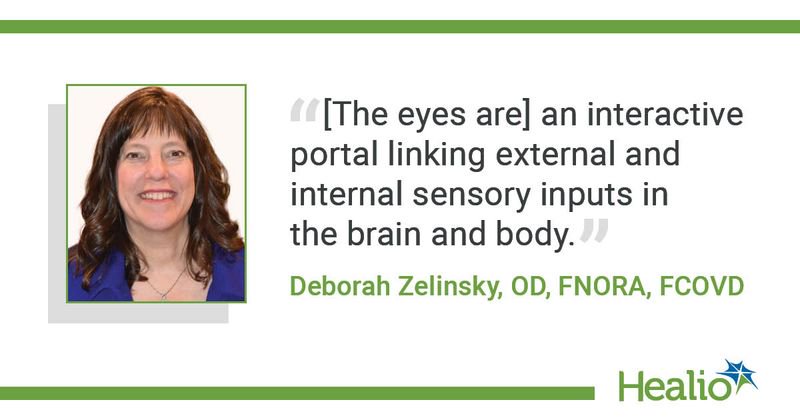BLOG: Let’s leave 20/20 in the 20th century
The key elements of the traditional eye exam — the phoropter and the Snellen eye chart — were developed in the late 19th and early 20th centuries.
Now that we’re almost one-quarter of the way through the 21st century, it is time to let go of the idea that ”perfect eyesight” can be characterized by these tools alone. In this century, we need to update the eye examination to encompass the growing field of oculomics, or the association of ophthalmic biomarkers with systemic health and disease.

Ocular manifestations of disease
The eye offers a unique opportunity for direct, in vivo observation of the neurosensory and microvascular systems. Ocular changes are associated with many systemic diseases, including inflammatory disease, neurodegenerative diseases and others. In fact, ocular manifestations sometimes provide the earliest detectable signs of disease, leading optometrists to regularly make lifesaving referrals.
Although diabetes and hypertension may be the best-known ocular-systemic interactions, the eyes and their nonimage-forming retinal pathways influence nearly every system in the body, including immune, digestive and endocrine.
For example, the mismatch of visual and vestibular signals after a traumatic brain injury can trigger the “fight or flight” response, in which the endocrine system switches away from hypothalamic-pituitary-thyroidal mode of normal metabolic and thyroid activity to hypothalamic-pituitary-adrenal mode, which allows the adrenal glands to pump out adrenaline and other stress hormones. These hormones alter digestion, breathing and sleep patterns.
It’s truly amazing how many connections there are between the eyes and the rest of the body.
Opportunities for early diagnosis, intervention
High-resolution, noninvasive ophthalmic imaging has accelerated the ability to detect disease and better understand the critical role of nonimage-forming retinal pathways. Optometry is at the forefront to influence these changes — once detected.
The latest research shows that retinal thinning reflects similar degeneration occurring in the brain. For instance, studies are showing that retinal changes mirror brain changes in patients with Alzheimer’s disease, multiple sclerosis, schizophrenia, bipolar disorder and Parkinson’s disease.
Because the retina is part of the central nervous system and accessible to noninvasive external stimulation, it offers opportunities not just for early diagnosis but for intervention in these conditions. Retinal neuromodulation, for example, may hold the key to influencing both glucose regulation and amyloid buildup in the brain, two processes implicated in Alzheimer’s disease.
‘Vanguard of change’
As president of the Society for Brain Mapping and Therapeutics in 2023, one of my goals is to work with legislators to begin to change existing Medicare codes and standards of care for optometry to ensure coverage for the comprehensive assessment and testing of both the image-forming (eyesight) and nonimage-forming pathways.
In the future, I believe that optometry will be at the vanguard of change for patients with learning problems, brain injuries and autonomic dysfunctions, and neurological disorders. I can also envision a time in which healthy, neurotypical patients will come to the optometrist for a range of diagnostic tests of the pupils, eye movements, retinal processing and tear film, just as they visit an internist for regular bloodwork and screening scans.
This is an exciting time for optometry as we move well beyond 20/20 central eyesight to understand the eyes as an interactive portal linking external and internal sensory inputs in the brain and body. This ties together what Arthur Skeffington, OD, known as “the father of behavioral optometry,” discussed regarding nonimage-forming optic nerve pathways governing thinking and movement, and the Neuro-Optometric Rehabilitation Association expanded by adding in postural shifts.
For more information:
Deborah Zelinsky, OD, FNORA, FCOVD, is executive director of research at the Mind-Eye Institute in Northbrook, Illinois, and president of the Society for Brain Mapping and Therapeutics. She has spent the past 35 years of her optometric career developing methods for assessing brain function and will be teaching “Delightful Duo of Oculomics and Optometry” at the 2023 NORA conference on brain-based rehabilitation. For more information and to register, visit https://noravisionrehab.org/about-nora/annual-conferences/2023-annual-conference.
Disclaimer: The views and opinions expressed in this blog are those of the authors and do not necessarily reflect the official policy or position of the Neuro-Optometric Rehabilitation Association unless otherwise noted. This blog is for informational purposes only and is not a substitute for the professional medical advice of a physician. NORA does not recommend or endorse any specific tests, physicians, products or procedures. For more on our website and online content, click here.
Collapse
